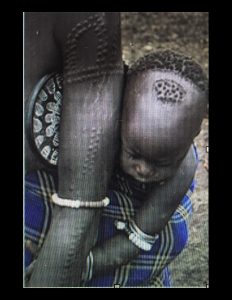A Visit to the Suri People
Visiting the Suri people is entering into a different world.
 Suri is the local name for an ethnic group living close to the South Sudan border in the southwestern region of Ethiopia. They are composed of three subgroups: Chai, Timaga and Baale, politically and territorially different, but all speaking South East Surmic languages belonging to the Nilo-Saharan language family. Within Ethiopia, their homeland is relatively remote, located in semi-arid plains, valleys and foothills. The Suri groups share a similar culture and show social and historical kinship with the Mursi people who dwell in the lower valley of the River Omo.
Suri is the local name for an ethnic group living close to the South Sudan border in the southwestern region of Ethiopia. They are composed of three subgroups: Chai, Timaga and Baale, politically and territorially different, but all speaking South East Surmic languages belonging to the Nilo-Saharan language family. Within Ethiopia, their homeland is relatively remote, located in semi-arid plains, valleys and foothills. The Suri groups share a similar culture and show social and historical kinship with the Mursi people who dwell in the lower valley of the River Omo.
The Suri are a proud and fierce people with deep cultural and traditional roots. Men and women go mostly naked, just with a loose piece of cloth draped carelessly over one shoulder which is not really meant to cover the nakedness, but serves for carrying things as well as a blanket at night.
Subcutaeneous skin scarifications on arms, heads, breasts and bellies, ear piercings adorned with flat, smooth river stones, pieces of metal or colorful discs and lip plates are an important part of Suri culture. Skin scarifications are extremely painful. Besides being a sing of beauty and prestige for both men and women, it is a way of introducing the young Suri to endure the sight of blood and pain.
Suri men pride themselves on their scars and how many they carry.
Young women, besides wearing skin scarifications, often have their lower teeth removed and their bottom lip detached, just keeping it hinged to the corners of the mouth. Then the hanging lip is stretched so as to allow the insertion of gradually increasing clay lip plates. Nowadays, having a lip plate is a sign of female beauty, but in former days, when slave traders raided the villages and carried off young men and women, the latter started to cut and deform their lower lips when they realized that the sight of a freshly cut, bleeding lower lip, hanging from the corners of their mouths, was so revolting to the harsh bunch of raiders that it saved them from being raped, taken slaves or both.
A famous ceremonial dueling is the traditional competition among mainly young Suri men, called Dunga stick fighting. The Dunga serves various purposes: It is a rite of passage for male youngsters, a means for measuring strength between young men from neighboring villages, for gaining respect from families and the community and it is particularly important when seeking a bride. Dunga fighting is extremely competitive and the participants bear the risk of getting seriously injured.
“….in the afternoon a friendly Dunga competition was to take place. In a clearing of the woods two groups from neighboring villages were going to meet. The clearing was a round, flat patch of red earth surrounded by trees and bushes and three paths leading towards the center.
After a while a drumming sound was drawing near. Out of the bushes, young, tall men materialized, most of them completely naked, some covered with white and reddish body paintings and all of them carrying a long stick of a light colored wood, and assembled at the entrance to the clearing.The drumming sound was a rhythmic muffled tone that surged from deep inside the chests of the stick fighters and came out of their mouths with the vibrating quality of a tambourine. It was a threatening sound.
After a moment, the competing group approached from the opposite direction and halted at the end of the path. The drumming sound became louder and fiercer until suddenly at the sign from an elderly man who held the role of referee, the fighting started.
One by one, men from the opposing groups stepped into the center of the patch and started hitting each other with their sticks as hard as they could, until one withdrew either badly hurt or accepting defeat. Meanwhile, the rest of the men fired the fighters on with their drumming sounds. On occasions, a heated discussions arose among the opposing crowds, and more often than not, someone rushed into the circle in support of his companion, but the dispute was always resolved peacefully.
Once in a while, the referee separated two opponents who were readying to fight, because, though coming from different villages, they belonged to the same family clan and therefore were not allowed to fight each other. It is against tribal law to allow family members to fight each other in a Dunga.
The competition went on until it was clear which village was the proud winner. Without further delay, just a short demonstration of joy from the victors, each group disappeared into the bushes, the way they had come. All that remained was the empty patch of red soil in the woods.”
(Description of a Dunga stick fighting, April 2018)
